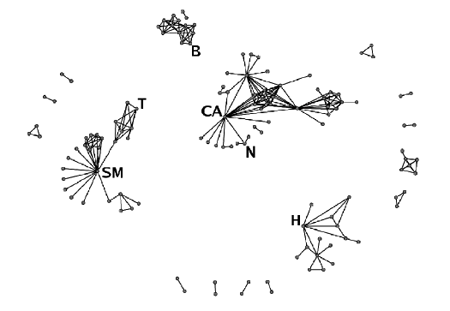Now, this is some research I can get behind. Physicist Pablo Gleiser of the National Council for Scientific and Technical Research in Buenos Aires, Argentina, is studying the Marvel Universe for the relationships its characters hold with one another. “The Marvel universe looks almost like a real social network,” says Gleiser.
The data comes from the Marvel Chronology Project database, drawing from previous work by Alberich, Miro-Julia, and Rossello to create bipartite collaboration network from superhero appearances in the comics. They studied the social web, comprised of 6486 characters in 12,942 issues, created by four decades of different authors writing comic books. Two characters were considered related if they appeared in the same issue. That 2002 study concluded that the Marvel characters can’t hid their artificial nature completely, even if the superhero network looked quite plausible (the clustering is not nearly as evident as it would be in real life).
Most real social networks are assortatively mixed by degree, that is, vertices with high degree tend to be connected to vertices with high-degree while vertices with low degree tend to be connected to vertices with low degree. On the other hand, most biological and technological networks present a disassorative mixing by degree, where vertices with high degree tend to be connected to vertices with low-degree
From “How to become a superhero” (PDF)
On the World Wide Web, the disassorative property is caused by ultra-linked sites serving as connectivity points. For the Marvel characters, this might be a function of popularity and marketing needs. A good way to test market new characters is to have them show up in the adventures with more established ones. Captain America, now deceased, has the most associations whereas Spider-Man has appeared in the most comic books.

Spider-Man (SM), Thing (T), Beast (B), Captain America (CA), Namor (N), and Hulk (H).
What Geiser did was to take this into account by weighting the network based on the frequency of the interactions. He found that the superheroes appear as well-formed groups and act as bridges to the various communities. Villains, on the other hand, are relatively isolated, appearing around the hub characters but not connecting communities. While this might suggest that success comes from strong support networks—it certainly doesn’t hurt—in this artificial network there are other factors at work. Namely, cultural expectations and a code of conduct for writers.
In 1954, spurred by a conservative mindset aimed at controlling what was deemed as deviant behavior, the Comics Code Authority created a set of rules comic book authors must follow to be able to get a stamp of approval. Those rules included allowing the good guys to triumph over evil, discouraging transgressions, and illustrating how America values can lead to success. If friendships and organizations are valued, then villains shouldn’t be party to them. There are some major exceptions—the Legion of Doom and Brotherhood of Mutants come to mind—but these came later. Ultimately the Code was defeated in a battle with Spider-Man, whose 1971 three-part series against drug use was distributed without the code because it mentioned narcotics. Currently, DC Comics (two minor series only) and Archie Comics are the only major publishers still submitting their books for CCA approval.
There are gender issues at work, as well. Villains don’t benefit from the traditional female role of connecting communities. For both good guys and bad, the central hubs in the superhero network are male. This, too, is a reflection of marketing and history and helps explain the artificial nature of the resulting network. However, it is also true that the strongest link in the entire Marvel Universe is between Spider-Man and Mary Jane (Watson) Parker, showing that “although the MU deals mainly with superheroes and villains the most popular plot is a love story.”